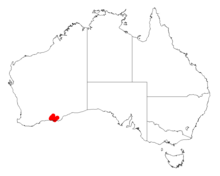| Acacia euthyphylla | |
|---|---|
| Scientific classification | |
| Kingdom: | Plantae |
| Clade: | Tracheophytes |
| Clade: | Angiosperms |
| Clade: | Eudicots |
| Clade: | Rosids |
| Order: | Fabales |
| Family: | Fabaceae |
| Subfamily: | Caesalpinioideae |
| Clade: | Mimosoid clade |
| Genus: | Acacia |
| Species: | A. euthyphylla
|
| Binomial name | |
| Acacia euthyphylla | |

| |
| Occurrence data from AVH | |
Acacia euthyphylla is a shrub belonging to the genus Acacia and the subgenus Phyllodineae native to Western Australia.
Description[edit]
The shrub typically grows to a height of 0.7 to 2.0 metres (2 to 7 ft).[1] It has a rounded to funnel-shaped habit with reasonably dense foliage. The slightly flexuose and finely ribbed branchlets are glabrous. The light green erect and linear phyllodes are straight to shallowly incurved with a length of 4 to 9 cm (1.6 to 3.5 in) and a width of 2 to 3 mm (0.079 to 0.118 in) and narrow towards the base.[2] It blooms between August and September producing yellow flowers.[1] Each inflorescence has two racemes with spherical flower heads that have a diameter of 4 to 5 mm (0.16 to 0.20 in) containing 18 to 21 golden flowers, The seed pods that form later are linear with a length of around 6 cm (2.4 in) and a width of 3.5 mm (0.14 in) which contain longitudinal seeds.[2]
Taxonomy[edit]
The species was first formally described by the botanist Bruce Maslin in 1999 as part of the work Acacia miscellany 16. The taxonomy of fifty-five species of Acacia, primarily Western Australian, in section Phyllodineae (Leguminosae: Mimosoideae) as published in the journal Nuytsia. The species was reclassified in 2003 as Racosperma euthyphyllum by Leslie Pedley and transferred back to the genus Acacia in 2006.[3]
Distribution[edit]
It is endemic to an area along the south coast of the Goldfields-Esperance region of Western Australia where it is found along the edges of salt lakes and marshes and seasonally wet swamp areas growing in sandy-clay-loam soils.[1] It is often part of tall myrtale shrubland and mallee woodland communities.[2]
See also[edit]
References[edit]
- ^ a b c "Acacia euthyphylla". FloraBase. Western Australian Government Department of Biodiversity, Conservation and Attractions.
- ^ a b c "Acacia euthyphylla". World Wide Wattle. Western Australian Herbarium. Retrieved 14 January 2019.
- ^ "Acacia euthyphylla Maslin". Atlas of Living Australia. Global Biodiversity Information Facility. Retrieved 14 January 2019.
